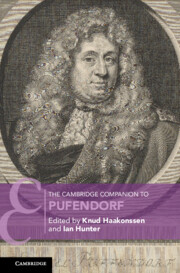Book contents
- The Cambridge Companion to Pufendorf
- Cambridge Companions to Law
- The Cambridge Companion to Pufendorf
- Copyright page
- Contents
- Contributors
- Abbreviations
- 1 Introduction: Life, Work and Historical Context
- 2 Politics and the Constitution of the Empire
- 3 Pufendorf’s Composite Method
- 4 The Metaphysics of Moral Entities
- 5 Human Nature, the State of Nature and Natural Law
- 6 Pacts, Language and Property
- 7 Family and Marriage
- 8 Pacts, Sovereignty and Forms of Government
- 9 The Civil Order: Law, Punishment and Social Value
- 10 The Law of Nations
- 11 Polemics and Controversies: Regarding the Eris Scandica
- 12 State, Church, Toleration, Reconciliation
- 13 Political Histories
- 14 Receptions, Contestations and Confusions
- Bibliography
- Index
3 - Pufendorf’s Composite Method
Published online by Cambridge University Press: 25 November 2022
- The Cambridge Companion to Pufendorf
- Cambridge Companions to Law
- The Cambridge Companion to Pufendorf
- Copyright page
- Contents
- Contributors
- Abbreviations
- 1 Introduction: Life, Work and Historical Context
- 2 Politics and the Constitution of the Empire
- 3 Pufendorf’s Composite Method
- 4 The Metaphysics of Moral Entities
- 5 Human Nature, the State of Nature and Natural Law
- 6 Pacts, Language and Property
- 7 Family and Marriage
- 8 Pacts, Sovereignty and Forms of Government
- 9 The Civil Order: Law, Punishment and Social Value
- 10 The Law of Nations
- 11 Polemics and Controversies: Regarding the Eris Scandica
- 12 State, Church, Toleration, Reconciliation
- 13 Political Histories
- 14 Receptions, Contestations and Confusions
- Bibliography
- Index
Summary
Pufendorf’s method comprised three distinguishable strains: a humanistic deployment of diverse sources, especially from classical antiquity; an eclectic demand to choose and fashion such materials anew; and a scientific insistence on observational evidence, systemic coherence, and procedural rigor. Each of these resisted disciplinary capture, authoritarian control, and subservience to extraneous, extra-philosophical interests – appealing instead to a rational and thus potentially universal audience. In Pufendorf the third strain became dominant and involved the others as auxiliary procedures. Like other early modern instances of “mathematical” or scientific method, it aspired – in principle, and within its characteristic domain of free, human action – to probative certitude and intellectual authority while remaining exposed to challenges and demands for articulation, thereby claiming the participatory assent of other, unbiased reasoners. Despite eschewing metaphysical foundations in favor of merely empirical supports, it claimed the peculiar force or authority animating explanatory and normative legality alike. It was, in short, rational and empirical at the same time, attempting to control the pull of these counter-tendencies toward more abstract, vacuous, and irreconcilable extremes. This aim was achieved by combining broadly prudential analyses of both human and divine intent, nourished by a realistic or pragmatic assessment of historical (actual and recorded) experience.
- Type
- Chapter
- Information
- The Cambridge Companion to Pufendorf , pp. 60 - 89Publisher: Cambridge University PressPrint publication year: 2022



